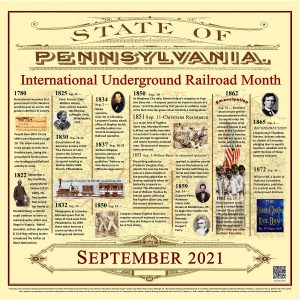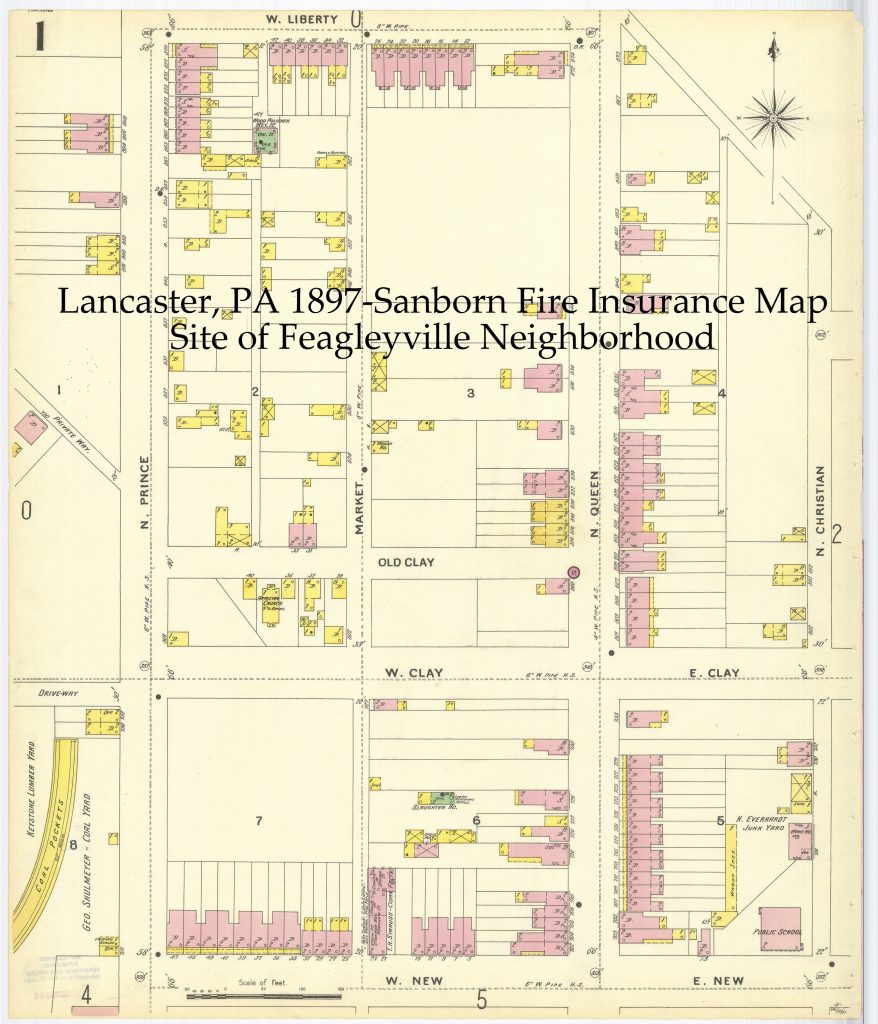Underground Railroad Heritage ReSources
Free downloads available here
Learn about & tour Underground Railroad heritage sites in Lancaster & York Counties
Click on this poster below…
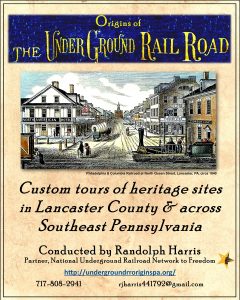
Download this new 30″ X 30″poster, commemorating International Underground Railroad Month, September 2021, featuring people and events associated with Pennsylvania’s role in this, America’s first civil rights movement.
Learn about plans to develop the historic Mifflin Farm in York County, an important site in the region’s Underground Railroad network.
2. PA Historic Resource Form – Mifflin House
Delve into the scant few records of the one-time thriving, racially and ethnically diverse neighborhood of Feagleyville, located in the northwest quadrant of the City of Lancaster.
Underground Railroad Network to Freedom Applications to the National Park Service for select sites in South Central Pennsylvania.
Research and documentation by Randolph Harris
Click here to download information about a property associated with Thaddeus Stevens that was a site of extensive Underground Railroad activity: The Caledonia Iron Works in Franklin County, PA. This site was accepted in the Network to Freedom in 2008.
Resistance at Christiana, a series of reports for a teacher study guide by Millersville University graduate students, 1998. Download here.
Also, for another perspective on Underground Railroad history, download a new guide to a better understanding of the role of Pennsylvania and its South Central Region in establishing a community standard of religious tolerance that for some transcended race, which, in turn created the seedbed for the movement we call The Underground Railroad…Visit this window into our past…
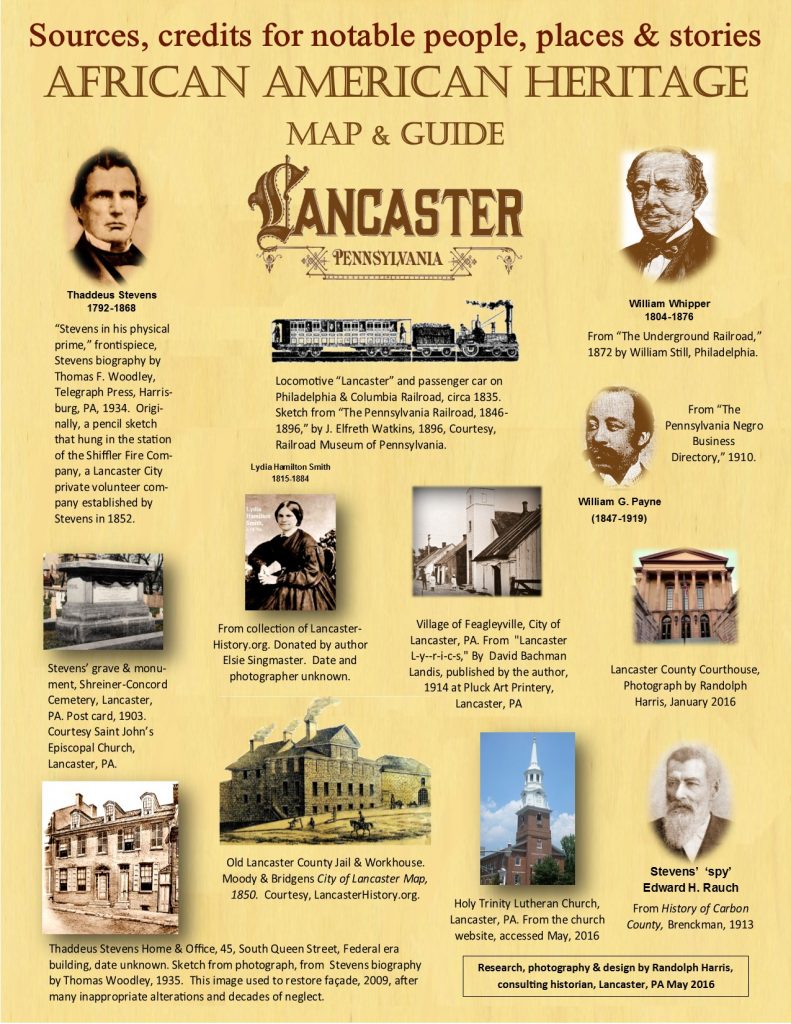
New Map & Guide available free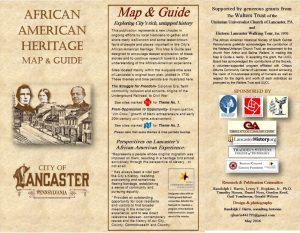
The African American Historical Society, in collaboration with the City of Lancaster Office of Promotion and four other community organizations, has just released its new Map & Guide highlighting more than 24 sites in the City of Lancaster that tell the story of the African American experience, from the Colonial Era to the mid-20th century.
The sites are located mainly within the 4-square-mile area of Lancaster’s original town plan, plotted in 1735.
Funded by grants from the Walters/Unitarian Universalist Church Trust, an endowment from Arthur and Selma Walters to the Unitarian Universalist Church of Lancaster, and Historic Lancaster Walking Tours, the map & guide is designed to assist guided or self-guided walking tours as well as driving excursions. The Walters/Unitarian Universalist Church Trust, an endowment from Arthur and Selma Walters to the Unitarian Universalist Church of Lancaster supports projects and events “that affirm the worth and dignity of all humans and that strive to increase the awareness of and respect for our environment,” according to the Church.
Featured sites include four properties that have been designated by the National Park Service/U.S. Department of the Interior as having authentic connections to the Underground Railroad: Fulton Opera House, built on the foundations of the Old Lancaster County Jail and Workhouse; Thaddeus Stevens and Lydia Smith Home and Office within the Lancaster County Convention Center; Thaddeus Stevens grave and monument at Shreiner-Concord Cemetery; and Bethel African Methodist Episcopal Church.
The Map & Guide has been developed by the Historical Society’s research and publication committee consisting of Randolph J. Harris, Leroy T. Hopkins, Jr., Ph.D. Timothy Niesen, Daniel Ness, Gordon Reed, Gail Tomlinson and Gerald Wilson.
Copies of the map also can be obtained at the City of Lancaster Visitor Center, 38 Penn Square, Downtown Lancaster, where guided walking tours depart to visit of some of the featured sites.
Or you can download this 12” x 18” color, two-sided foldable map & guide. New Map & Guide available free
Another rare record set available for download: The Entries — known as “Returns” — recorded for the Pennsylvania Gradual Abolition Act of 1780 for Lancaster and other South Central PA Counties. This 64-page document contains the names of all people who enslaved African Americans and an enumeration of those who were enslaved by name, gender, age and other descriptions.
Additional articles, reports and videos to help you explore this region’s Underground Railroad origins:
“Underground Railroad clues point here: Research into origin shows support of freedom seekers as early as 1804,” by Randolph Harris, Intelligencer Journal/ New Era, Lancaster, PA, April 26, 2011.
“Among These Hills: African Americans in Lancaster County’s Southern End,” A paper presented by Leroy T. Hopkins, Jr. to the Southern Lancaster County Historical Society, July 6, 2000.
Thaddeus Stevens : America’s Forgotten Hero: Franklin & Marshall College, Community Media Lab, 2003. Available on YouTube:
https://www.youtube.com/watch?v=T9B07idGs6Y
“Testing the Limits of Tolerance: Blacks and the Social Order in Columbia, Pennsylvania, 1800-1851”. By Willis L. Shirk, Jr. Pennsylvania History. Vol. 60, p. 35.
“The Pilgrim’s Pathway: the Underground Railroad in Lancaster County. Lancaster, Pa.” By Charles D. Spotts, Community Historians, 1966.
UGRR Railcar – Song of the Fugitive, 1854 ballad.

